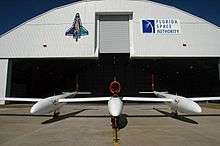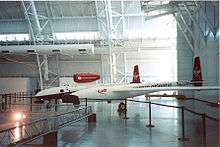Virgin Atlantic GlobalFlyer
| Virgin Atlantic GlobalFlyer | ||
|---|---|---|
 | ||
| GlobalFlyer at the Mojave Spaceport in April 2004 | ||
| Role | Long-range aircraft for record attempt | |
| Manufacturer | Scaled Composites | |
| Designer | Burt Rutan | |
| First flight | 2005 | |
| Retired | March 17, 2006 | |
| Primary user | Steve Fossett | |
| Number built | 1 | |
|
|
Career | |
| Registration | N277SF | |
| Preserved at | National Air and Space Museum Steven F. Udvar-Hazy Center | |

The Scaled Composites Model 311 Virgin Atlantic GlobalFlyer (registered N277SF) is an aircraft designed by Burt Rutan in which Steve Fossett flew a solo nonstop airplane flight around the world in 2 days 19 hours and 1 minute (67 hours 1 minute) from February 28 to March 3, 2005. The flight speed of 590.7 kilometres per hour (367.0 mph) set the world record for the fastest nonstop non-refueled circumnavigation, beating the mark set by the previous Rutan-designed Voyager aircraft at 9 days 3 minutes and an average speed of 116 miles per hour (187 km/h).
The aircraft was owned by the pilot Steve Fossett, sponsored by Richard Branson's airline, Virgin Atlantic, and built by Burt Rutan's company, Scaled Composites. The two companies subsequently went on to work together on Virgin Galactic.
Between February 8, 2006 and February 11, 2006, Fossett flew the GlobalFlyer for the longest aircraft flight distance in history: 25,766 miles (41,466 km).
Construction
The GlobalFlyer was specifically designed to make an uninterrupted (non-refueled) circumnavigation of the globe with a single pilot. Unusual for a modern civil aircraft, the GlobalFlyer has only a single jet engine.
Physically, the GlobalFlyer has twin tail booms mounted outboard of a shorter central fuselage nacelle. The pressurized cockpit is located in the front of the fuselage and provides 7 feet (2 m) of space in which the pilot sits. The single turbofan engine is mounted in an unusual position above the fuselage at a point several feet behind the cockpit, seen also on the Heinkel He 162 Salamander and Cirrus Vision. The outboard booms contain large fuel tanks and end in tail surfaces which are not cross-connected.
The aircraft is constructed of carbon fiber reinforced epoxy, the main structural member being a high aspect ratio single-spar wing of 114 foot (35 m) span. The wings are made of high-strength composite materials with the skin of the aircraft being a graphite/epoxy and Aramid honeycomb. The use of lightweight materials permits the fuel (in thirteen tanks) to compose 83% of the take-off weight.
The aircraft had an estimated lift to drag ratio of 37.[1] The aerodynamic drag is so low that, even with the engine idling, the aircraft can only descend at a maximum of 700 feet per minute (3.6 m/s). Twin drogue parachutes were used to slow the GlobalFlyer to landing speeds.
The earlier Voyager aircraft suffered from design flaws that allowed it to warp in shape very easily, so the GlobalFlyer is designed to have greater stiffness. A single jet engine design was chosen for the GlobalFlyer for increased reliability over piston engines and faster circumnavigation for the solo pilot.
The GlobalFlyer is designed to operate at high altitudes where the air is colder, yet fuel heaters were not included in its design. There was some concern that the fuel might freeze if the aircraft used standard jet fuel. Therefore, the GlobalFlyer's Williams International FJ44-3 ATW turbofan (which normally takes Jet-A fuel), was re-calibrated to burn a fuel with a substantially lower freezing point: JP-4 fuel.
First solo nonstop circumnavigation
In January 2005, following solo test flights at Mojave, California by Chief Engineer Jon Karkow and pilot Steve Fossett, Fossett moved the GlobalFlyer to the Salina Municipal Airport in Salina, Kansas, where a recently resurfaced runway of 12,300 feet (3750 m) would accommodate the anticipated long takeoff roll. The round the world attempt was delayed until 28 February 2005 to obtain a weather forecast with low turbulence for the fragile GlobalFlyer and good tailwinds.
Mission Control was at the Salina campus of Kansas State University, located adjacent to the Salina Municipal Airport.
A tailwind was essential to making the 36,787.559 kilometres (22,858.729 mi) that it needed to fly to meet the FAI’s definition of circumnavigation, the length of the Tropic of Cancer. The GlobalFlyer was designed to complete the circumnavigation with minimal reserves of fuel. As it turned out, a design flaw in the fuel venting system resulted in the loss of about 1,200 kg (2,600 lb) of fuel early in the flight. This forced Steve Fossett and Mission Control to decide whether to abort the flight as it reached the Pacific Ocean near Japan. Steve Fossett chose to delay the final decision until he reached Hawaii. By that time, favorable winds encouraged the mission team to attempt to complete the circumnavigation.
Virgin Atlantic GlobalFlyer landed at Salina at 19:50 UTC (13:50 CST) on 3 March 2005, having completed its circumnavigation in 2 days, 19 hours, 1 minute and 46 seconds. As of 2014, this is the fastest world trip in its class at a speed of 550.78 km/h.[2] The distance flown was determined to be 36,912 kilometres (22,936 mi), only 125 kilometres (78 mi) above the minimum distance required.
Longest distance aircraft flight (2006)

Steve Fossett planned a second circumnavigation in the GlobalFlyer in 2006, this time taking off from the Kennedy Space Center in Florida, flying eastbound around the world then crossing the Atlantic a second time and then landing at Kent International Airport in Kent, England.
The objective was to break the Absolute Distance Without Landing Record for airplanes and to exceed the longest distance by any kind of aircraft which was achieved by the Round the World Balloon flight of Bertrand Piccard and Brian Jones in 1999.
On Wednesday, February 8, 2006, at 12:22 UTC, GlobalFlyer took off and flew eastbound from Kennedy Space Center, and landed after a flight duration of 76 hours, 45 minutes with an official distance of 25,766 miles (41,467 km).[3][4]
This distance set a new record for the longest aircraft flight in history, breaking the old records of 24,987 miles (40,212 km) in an airplane and 25,360 miles (40,814 km) in a balloon. The landing was made at Bournemouth Airport, England, Fossett having declared an emergency and diverting because of a generator failure at 40,000 feet (12,000 m). Generator failure meant that he had about 25 minutes until his batteries were exhausted, when he would have lost all electrical power. To add to the drama, there was ice on the inside of the canopy obstructing Fossett's view, making his landing virtually blind; one tire was flat from the takeoff roll and the remaining main tire burst on touchdown due to frozen brakes; and the fuel remaining was indicated to be only 200 lb (91 kg).
There was some relatively minor damage, such as a broken aileron hinge and a jammed intake valve, but otherwise the aircraft survived intact.
Closed circuit distance flight and retirement
Steve Fossett flew the GlobalFlyer to one more major aviation record: the Absolute Distance Over a Closed Circuit. A Closed Circuit record must take off and land at the same place and the distance is measured over verifiable waypoints. Dick Rutan and Jeana Yeager had already flown the Voyager around the world in 1986, so a longer closed circuit course was needed to break their record. Fossett started in Salina, Kansas on March 14, 2006 and flew eastbound around the world. Upon leaving Japan he flew south and then tracked along the Equator in order to maximize the distance while crossing the Pacific Ocean. He landed in Salina, Kansas on March 17, 2006 after traversing a total of 25,294 miles (40,707 km) to set a new Absolute Distance Over a Closed Circuit Record.[5]
With this final record flight before retirement, the GlobalFlyer had set three of the seven absolute world records of airplanes as ratified by the Fédération Aéronautique Internationale. The GlobalFlyer is now on permanent display at the Smithsonian Institution National Air and Space Museum Steven F. Udvar-Hazy Center.
Specifications
General characteristics
- Crew: 1
- Length: 44 ft 1 in (13.44 m)
- Wingspan: 114 ft 0 in (34.75 m)
- Height: 13 ft 3 in (4.04 m)
- Wing area: 400 sq ft (37 m2)
- Aspect ratio: 32.6
- Empty weight: 3,700 lb (1,678 kg)
- Gross weight: 22,100 lb (10,024 kg)
- Powerplant: 1 × Williams FJ44-2 turbofan, 2,300 lbf (10 kN) thrust
Performance
- Maximum speed: 342 mph (550 km/h; 297 kn)
- Range: 25,766 mi (22,390 nmi; 41,466 km)
- Service ceiling: 51,000 ft (15,545 m)
- Maximum glide ratio: 37
See also
- Concorde holds the fastest refuelled circumnavigation
References
- ↑ David Noland, "Steve Fossett and Burt Rutan's Ultimate Solo: Behind the Scenes," Popular Mechanics, Feb. 2005 (web version)
- ↑ "FAI Record ID #10897 - Speed around the world, non-stop and non-refuelled" Fédération Aéronautique Internationale (FAI). Retrieved: 18 September 2014.
- ↑ "FAI Record ID #13083 - Distance" Fédération Aéronautique Internationale (FAI). Retrieved: 18 September 2014.
- ↑ "FAI Record ID #13081 - Distance" Fédération Aéronautique Internationale (FAI). Retrieved: 18 September 2014.
- ↑ "FAI Record ID #13236 - Distance over a closed course" Fédération Aéronautique Internationale (FAI). Retrieved: 18 September 2014.
External links
| Wikimedia Commons has media related to GlobalFlyer. |
- Scaled Composites home page
- SC Global Flyer page
- GlobalFlyer Live Flight Tracking dead link
- "Fossett launches record attempt", BBC News – March 1, 2005
- "Steve Fossett and Burt Rutan's Ultimate Solo: Behind the Scenes" (from Popular Mechanics) dead link
- GlobalFlyer at National Air and Space Museum
